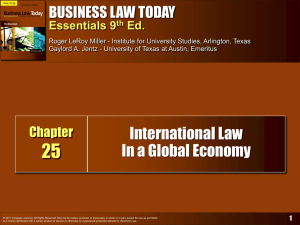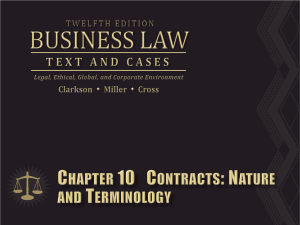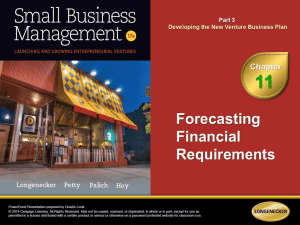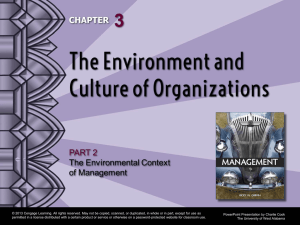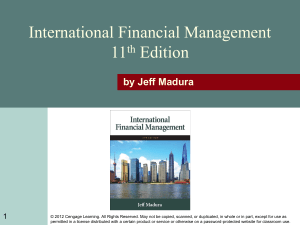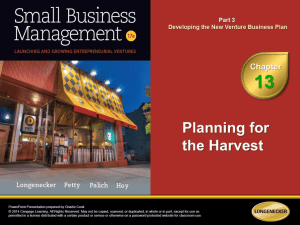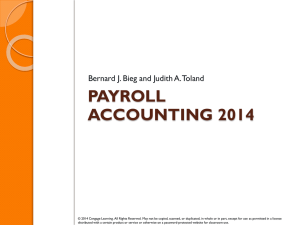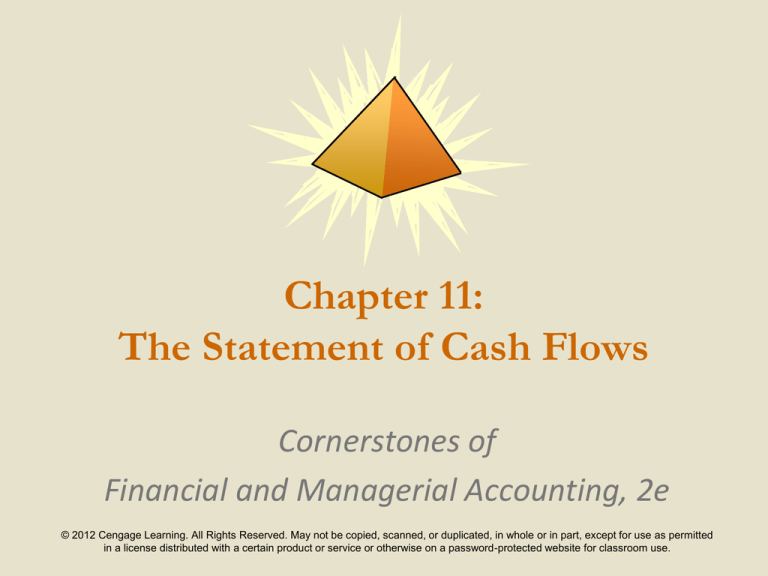
Chapter 11:
The Statement of Cash Flows
Cornerstones of
Financial and Managerial Accounting, 2e
© 2012 Cengage Learning. All Rights Reserved. May not be copied, scanned, or duplicated, in whole or in part, except for use as permitted
in a license distributed with a certain product or service or otherwise on a password-protected website for classroom use.
Learning Objectives
1.
2.
3.
4.
5.
6.
7.
8.
9.
Explain the purpose of a statement of cash flows.
Identify and classify business activities that produce cash inflows and
outflows.
Understand the relationship between changes in cash and the changes in
the balance sheet accounts.
Prepare the cash flows from operating activities section of a statement
of cash flows using the indirect method.
Prepare the cash flows from investing activities section of a statement of
cash flows.
Prepare the cash flows from financing activities section of a statement of
cash flows.
Analyze information contained in the statement of cash flows.
(Appendix) Prepare the cash flows from operating activities section of a
statement of cash flows using the direct method.
(Appendix) Use a spreadsheet to prepare the statement of cash flows.
© 2012 Cengage Learning. All Rights Reserved. May not be copied, scanned, or duplicated, in whole or in part, except for use as permitted in a
license distributed with a certain product or service or otherwise on a password-protected website for classroom use.
1
The Role of
the Statement of Cash Flows
► Information in a statement of cash flows helps investors,
creditors, and others in the following ways:
►Assessing a company’s ability to produce future net cash
inflows;
►Judging a company’s ability to meet its obligations and
pay dividends;
►Estimating the company’s needs for external financing;
►Understanding the reasons for the differences between
net income and related cash receipts and cash payments;
and
►Evaluating the balance sheet effects of both cash and
noncash investing and financing transactions.
© 2012 Cengage Learning. All Rights Reserved. May not be copied, scanned, or duplicated, in whole or in part, except for use as permitted in a
license distributed with a certain product or service or otherwise on a password-protected website for classroom use.
2
Cash Flow Classifications
► Because our focus is on cash flows, it is important to have a clear
understanding of what is included in the term cash.
► For purposes of the statement of cash flows, cash includes both funds
on hand (coins and currency) and cash equivalents.
► Cash equivalents are short-term, highly liquid investments that are
readily convertible to cash and have original maturities of three
months or less.
► Examples: Money market funds, investments in U.S. government
securities (treasury bills)
► Because of their high liquidity or nearness to cash, cash
equivalents are treated as cash in the statement of cash flows.
► During an accounting period, a company engages in the three
fundamental business activities—operating activities, investing
activities, and financing activities. Each of these activities can
contribute to (a cash inflow) or reduce (a cash outflow) a company’s
cash balance.
© 2012 Cengage Learning. All Rights Reserved. May not be copied, scanned, or duplicated, in whole or in part, except for use as permitted in a
license distributed with a certain product or service or otherwise on a password-protected website for classroom use.
2
How the Statement of Cash Flows
Links the Two Balance Sheets
© 2012 Cengage Learning. All Rights Reserved. May not be copied, scanned, or duplicated, in whole or in part, except for use as permitted in a
license distributed with a certain product or service or otherwise on a password-protected website for classroom use.
2
Cash Flows
from Operating Activities
► Cash flows from operating activities (or operating cash flows) are
the cash inflows and outflows that relate to acquiring (purchasing
or manufacturing), selling, and delivering goods or services.
► Cash inflows from operating activities include:
► cash sales to customers
► collection of accounts receivable arising from credit sales
► cash dividends received
► interest received on investments in equity and debt securities
► Cash outflows from operating activities include payments:
► to suppliers for goods and services
► to employees for wages and salaries
► to governments for taxes
► to lenders for interest on debt.
© 2012 Cengage Learning. All Rights Reserved. May not be copied, scanned, or duplicated, in whole or in part, except for use as permitted in a
license distributed with a certain product or service or otherwise on a password-protected website for classroom use.
2
Cash Flows
from Investing Activities
► Cash flows from investing activities (or investing cash flows) are
the cash inflows and outflows that relate to acquiring and disposing
of operating assets and investments in other companies (current
and long-term), lending money, and collecting loans.
► Cash inflows from investing activities include cash received from:
► the sale of property, plant, and equipment
► the collection of the principal amount of a loan (a note receivable)
► the sale of investments in other companies
► Cash outflows from investing activities include payments made to:
► acquire property, plant, and equipment
► purchase debt or equity securities of other companies as an
investment
► loan money to others (notes receivable)
© 2012 Cengage Learning. All Rights Reserved. May not be copied, scanned, or duplicated, in whole or in part, except for use as permitted in a
license distributed with a certain product or service or otherwise on a password-protected website for classroom use.
2
Cash Flows
from Financing Activities
►Cash flows from financing activities (or financing cash
flows) include obtaining resources from creditors and
owners.
►Cash inflows from financing activities include cash
received from the:
►issuance of stock
►issuance of debt (bonds or notes payable)
►Cash outflows from financing activities include cash
payments to:
►repay the principal amount borrowed (bonds or notes payable)
►repurchase a company’s own stock (treasury stock)
►pay dividends
© 2012 Cengage Learning. All Rights Reserved. May not be copied, scanned, or duplicated, in whole or in part, except for use as permitted in a
license distributed with a certain product or service or otherwise on a password-protected website for classroom use.
2
Noncash Investing
and Financing Activities
► Occasionally, investing and financing activities take place
without affecting cash.
► For example, a company may choose to acquire an operating asset
(such as a building) by issuing long-term debt.
► Alternatively, a company may acquire one asset by
exchanging it for another.
► These types of activities are referred to as noncash investing
and financing activities.
► Because these activities do not involve cash, they are not reported on
the statement of cash flows.
► Any significant noncash investing and financing activities are required
to be reported in a supplementary schedule that is shown either at
the bottom of the statement of cash flows or in the notes to the
financial statements.
© 2012 Cengage Learning. All Rights Reserved. May not be copied, scanned, or duplicated, in whole or in part, except for use as permitted in a
license distributed with a certain product or service or otherwise on a password-protected website for classroom use.
2
Summary of the
Classification of Cash Flows
© 2012 Cengage Learning. All Rights Reserved. May not be copied, scanned, or duplicated, in whole or in part, except for use as permitted in a
license distributed with a certain product or service or otherwise on a password-protected website for classroom use.
2
Cornerstone 11-1
Classifying Business Activities
© 2012 Cengage Learning. All Rights Reserved. May not be copied, scanned, or duplicated, in whole or in part, except for use as permitted in a
license distributed with a certain product or service or otherwise on a password-protected website for classroom use.
2
Cornerstone 11-1
Classifying Business Activities
(continued)
© 2012 Cengage Learning. All Rights Reserved. May not be copied, scanned, or duplicated, in whole or in part, except for use as permitted in a
license distributed with a certain product or service or otherwise on a password-protected website for classroom use.
2
Format of
the Statement of Cash Flows
© 2012 Cengage Learning. All Rights Reserved. May not be copied, scanned, or duplicated, in whole or in part, except for use as permitted in a
license distributed with a certain product or service or otherwise on a password-protected website for classroom use.
2
You Decide
Statement of Cash Flow Classifications
© 2012 Cengage Learning. All Rights Reserved. May not be copied, scanned, or duplicated, in whole or in part, except for use as permitted in a
license distributed with a certain product or service or otherwise on a password-protected website for classroom use.
3
Analyzing the Accounts
for Cash Flow Data
► Unlike the balance sheet and the income statement, the
statement of cash flows cannot be prepared by simply using
information obtained from an adjusted trial balance prepared
using the accrual basis of accounting.
► The accrual-basis numbers in the balance sheet and the
income statement must be adjusted to a cash basis to
understand why cash changed.
► Using the fundamental accounting equation, these changes
can be summarized as:
© 2012 Cengage Learning. All Rights Reserved. May not be copied, scanned, or duplicated, in whole or in part, except for use as permitted in a
license distributed with a certain product or service or otherwise on a password-protected website for classroom use.
3
Cornerstone 11-2
Classifying Changes in Balance Sheet Accounts
© 2012 Cengage Learning. All Rights Reserved. May not be copied, scanned, or duplicated, in whole or in part, except for use as permitted in a
license distributed with a certain product or service or otherwise on a password-protected website for classroom use.
3
Cash Flow Classifications and
Changes in the Balance Sheet Accounts
© 2012 Cengage Learning. All Rights Reserved. May not be copied, scanned, or duplicated, in whole or in part, except for use as permitted in a
license distributed with a certain product or service or otherwise on a password-protected website for classroom use.
3
Preparing a
Statement of Cash Flows
►To prepare a statement of cash flows, you need:
►Comparative balance sheets: Used to determine the changes
in assets, liabilities, and stockholders’ equity during a period
►Current income statement: Used to determine cash flows
from operating activities
►Additional information about selected accounts: Used to
determine the reason why cash was received or paid
© 2012 Cengage Learning. All Rights Reserved. May not be copied, scanned, or duplicated, in whole or in part, except for use as permitted in a
license distributed with a certain product or service or otherwise on a password-protected website for classroom use.
3
Preparing a
Statement of Cash Flows (Continued)
►Five basic steps are required to prepare the
statement of cash flows.
►Step 1: Compute the net cash flow from operating
activities.
►Step 2: Compute the net cash flow from investing activities.
►Step 3: Compute the net cash flow from financing activities.
►Step 4: Combine the net cash flows from operating,
investing, and financing activities to obtain the net increase
(decrease) in cash for the period.
►Step 5: Compute the change in cash for the period and
compare this with the change in cash from Step 4.
© 2012 Cengage Learning. All Rights Reserved. May not be copied, scanned, or duplicated, in whole or in part, except for use as permitted in a
license distributed with a certain product or service or otherwise on a password-protected website for classroom use.
4
Preparing Cash Flows
from Operating Activities
► The cash flows from operating activities section of the statement of cash
flows may be prepared using either of two methods: the direct method or
the indirect method.
► In the direct method, cash inflows and cash outflows are listed for each
type of operating activity that a company performs.
► These cash flows are generally computed by adjusting each item on the
income statement by the changes in the related current asset or liability
accounts.
► The indirect method does not report individual cash inflows and outflows.
► Instead, it focuses on the differences between net income and operating cash
flow. The indirect method begins with net income and then adjusts it for
noncash items to produce net cash flow from operating activities.
► Adjustments to net income are necessary for two reasons under the
indirect method:
► to eliminate income statement items that do not affect cash (such as
depreciation and gains/losses on sales of assets) and
► to adjust accrual-basis revenues and expenses to cash receipts and cash
payments.
© 2012 Cengage Learning. All Rights Reserved. May not be copied, scanned, or duplicated, in whole or in part, except for use as permitted in a
license distributed with a certain product or service or otherwise on a password-protected website for classroom use.
4
Preparing the Statement of Cash Flows
Using The Indirect Method
► Under the indirect method, four types of adjustments must
be made to net income to adjust it to net cash flow from
operating activities:
►Add to net income any noncash expenses and subtract from
net income any noncash revenues.
►Add to net income any losses and subtract from net income
any gains.
►Add to net income any decreases in current assets or
increases in current liabilities that are related to operating
activities.
►Subtract from net income any increases in current assets and
decreases in current liabilities that are related to operating
activities.
© 2012 Cengage Learning. All Rights Reserved. May not be copied, scanned, or duplicated, in whole or in part, except for use as permitted in a
license distributed with a certain product or service or otherwise on a password-protected website for classroom use.
4
Financial Statements
for Brooke Sportswear
© 2012 Cengage Learning. All Rights Reserved. May not be copied, scanned, or duplicated, in whole or in part, except for use as permitted in a
license distributed with a certain product or service or otherwise on a password-protected website for classroom use.
4
Cornerstone 11-3
Calculating Net Cash Flow from
Operating Activities: Indirect Method
© 2012 Cengage Learning. All Rights Reserved. May not be copied, scanned, or duplicated, in whole or in part, except for use as permitted in a
license distributed with a certain product or service or otherwise on a password-protected website for classroom use.
4
Cornerstone 11-3
Calculating Net Cash Flow from
Operating Activities: Indirect Method
(continued)
© 2012 Cengage Learning. All Rights Reserved. May not be copied, scanned, or duplicated, in whole or in part, except for use as permitted in a
license distributed with a certain product or service or otherwise on a password-protected website for classroom use.
4
Summary of Adjustments Required to
Calculate Cash Flow from Operating
Activities under the Indirect Method
© 2012 Cengage Learning. All Rights Reserved. May not be copied, scanned, or duplicated, in whole or in part, except for use as permitted in a
license distributed with a certain product or service or otherwise on a password-protected website for classroom use.
4
You Decide
Operating Cash Flow and the Quality of Earnings
© 2012 Cengage Learning. All Rights Reserved. May not be copied, scanned, or duplicated, in whole or in part, except for use as permitted in a
license distributed with a certain product or service or otherwise on a password-protected website for classroom use.
5
Preparing and Analyzing
Cash Flows from Investing Activities
► The second major section of the statement of cash flows reports the net
cash flow from investing activities.
► Information for preparing the investing activities portion of the statement
of cash flows is obtained from the investment and long-term asset
accounts.
► To analyze investing activities, use the three basic steps shown below:
© 2012 Cengage Learning. All Rights Reserved. May not be copied, scanned, or duplicated, in whole or in part, except for use as permitted in a
license distributed with a certain product or service or otherwise on a password-protected website for classroom use.
5
Cornerstone 11-4
Reporting Net Cash Flow from Investing Activities
© 2012 Cengage Learning. All Rights Reserved. May not be copied, scanned, or duplicated, in whole or in part, except for use as permitted in a
license distributed with a certain product or service or otherwise on a password-protected website for classroom use.
6
Preparing Cash Flows
from Financing Activities
► The intent of the financing activities section of the statement
of cash flows is to identify inflows and outflows of cash arising
from business activities that either produced capital (longterm debt or stockholders’ equity) for the company or repaid
capital supplied to the company.
► Three basic steps are used to analyze financing activities:
► Step 1: Recreate the journal entries to describe the activities that took
place during the period.
► Step 2: Record the cash flows as inflows or outflows of cash in the
financing activities section of the statement of cash flows.
► Step 3: Analyze the account to make sure the account activity has
been completely explained.
© 2012 Cengage Learning. All Rights Reserved. May not be copied, scanned, or duplicated, in whole or in part, except for use as permitted in a
license distributed with a certain product or service or otherwise on a password-protected website for classroom use.
6
Cornerstone 11-5
Reporting Net Cash Flow from Financing Activities
© 2012 Cengage Learning. All Rights Reserved. May not be copied, scanned, or duplicated, in whole or in part, except for use as permitted in a
license distributed with a certain product or service or otherwise on a password-protected website for classroom use.
6
You Decide
Understanding Patterns in
the Statement of Cash Flows
© 2012 Cengage Learning. All Rights Reserved. May not be copied, scanned, or duplicated, in whole or in part, except for use as permitted in a
license distributed with a certain product or service or otherwise on a password-protected website for classroom use.
7
Using the Statement of Cash Flows
►Effective analysis of the statement of cash flows
requires the following:
►an examination of the statement of cash flows itself,
► a comparison of the information on the current statement
of cash flows with earlier statements, and
► a comparison of the information in the current statement
of cash flows with information from other companies’
statements of cash flow.
© 2012 Cengage Learning. All Rights Reserved. May not be copied, scanned, or duplicated, in whole or in part, except for use as permitted in a
license distributed with a certain product or service or otherwise on a password-protected website for classroom use.
7
Examining the
Statement of Cash Flows
► One of the most important insights that can be gained by
inspecting the current period’s statement of cash flows is an
estimate of how long it will take to recover the cash outflow
associated with long-term uses of cash (such as purchase of
property, plant, and equipment).
► As investments in property, plant, and equipment are likely to
require several profitable years before the investment is
completely recovered through the sale of goods or services,
prudent managers will seek long-term sources of cash such as
long-term debt or equity which will not need to be repaid
before the original investment has been recovered through
profitable operations.
© 2012 Cengage Learning. All Rights Reserved. May not be copied, scanned, or duplicated, in whole or in part, except for use as permitted in a
license distributed with a certain product or service or otherwise on a password-protected website for classroom use.
7
Examining the
Statement of Cash Flows (continued)
► The sources most frequently used to provide long-term cash inflows are
operations, the sale of long-term debt, and the sale of stock. Of these
three, operations is generally considered the least risky, or the most
controllable.
► The sale of debt or equity requires that investors or creditors make sizable
commitments to the company. Although cash inflows from operations also
require that an outsider (the customer) make a commitment, the size and
timing of a customer’s cash commitments are more flexible.
► Thus, it is more likely that the company can produce cash inflows from
customers on a regular basis. For this reason, most companies attempt to
secure a sizable portion of their total cash inflows from operations.
► Generally, analysts view cash flows from operations as the most important
section of the statement of cash flows because, in the long-run, this will be
the company’s source of cash used to provide a return to investors and
creditors.
© 2012 Cengage Learning. All Rights Reserved. May not be copied, scanned, or duplicated, in whole or in part, except for use as permitted in a
license distributed with a certain product or service or otherwise on a password-protected website for classroom use.
7
Comparing the Statement of
Cash Flows from Several Periods
►An analysis of the statement of cash flows also requires a
comparison of the company’s current statement of cash
flows with earlier statements of cash flow.
►Typically, several consecutive years should be analyzed in
order to determine trends in cash inflows and cash
outflows.
►Financial statement users rely on summary cash flow
measures to help them make assessments.
►Free cash flow
►Cash flow adequacy
© 2012 Cengage Learning. All Rights Reserved. May not be copied, scanned, or duplicated, in whole or in part, except for use as permitted in a
license distributed with a certain product or service or otherwise on a password-protected website for classroom use.
7
Free Cash Flows
►A company’s free cash flow represents the cash
flow that a company is able to generate after
considering the maintenance or expansion of its
assets (capital expenditures) and the payment of
dividends.
►Free cash flow allows a company to pursue profitgenerating opportunities.
►However, negative free cash flow is not necessarily a
bad thing, but may indicate large investments in
productive assets, which is good for a long-run
strategy.
© 2012 Cengage Learning. All Rights Reserved. May not be copied, scanned, or duplicated, in whole or in part, except for use as permitted in a
license distributed with a certain product or service or otherwise on a password-protected website for classroom use.
7
Cash Flow Adequacy Ratio
►A second useful measure is the cash flow adequacy
ratio.
►The cash flow adequacy ratio provides a measure of the
company’s ability to meet its maturing debt obligations
and is calculated as:
►The cash flow adequacy ratio is also an indicator of
whether the company has the capacity to borrow
additional debt.
© 2012 Cengage Learning. All Rights Reserved. May not be copied, scanned, or duplicated, in whole or in part, except for use as permitted in a
license distributed with a certain product or service or otherwise on a password-protected website for classroom use.
7
Cornerstone 11-6
Analyzing Free Cash Flow and Cash Flow Adequacy
© 2012 Cengage Learning. All Rights Reserved. May not be copied, scanned, or duplicated, in whole or in part, except for use as permitted in a
license distributed with a certain product or service or otherwise on a password-protected website for classroom use.
7
Comparing the Statement of Cash
Flows to Similar Companies
► Finally, the analysis of the statement of cash flows requires
comparisons with similar companies.
► Such comparisons provide good reference points because
similar companies generally secure cash from similar sources
and are likely to spend cash for similar activities.
► Comparative analysis can reveal significant deviations in
► the amounts of cash inflows,
► the source of those inflows, and
► the types of activities to which cash is applied.
► When significant differences are found among similar
companies, explanations should be searched for in the other
financial statements, notes accompanying the statements, or
from management.
© 2012 Cengage Learning. All Rights Reserved. May not be copied, scanned, or duplicated, in whole or in part, except for use as permitted in a
license distributed with a certain product or service or otherwise on a password-protected website for classroom use.
8
Appendix 11A:
The Direct Method
►In the direct method of computing net cash flow
from operating activities, inflows and outflows of
cash are listed for each type of operating activity
that a company performs.
►This involves adjusting each item on the income
statement by the changes in the related current
asset or liability accounts.
►Typical operating cash flows and adjustments
necessary to compute them follow.
© 2012 Cengage Learning. All Rights Reserved. May not be copied, scanned, or duplicated, in whole or in part, except for use as permitted in a
license distributed with a certain product or service or otherwise on a password-protected website for classroom use.
8
Cash Collected from Customers
► Sales revenue includes both cash sales and credit sales.
► When all sales are for cash, the cash collected from customers
equals sales.
► However, when credit sales are made, the amount of cash
that was collected during a period must be determined by
analyzing the sales and accounts receivable accounts.
► A general formula to compute cash collections from
customers is:
© 2012 Cengage Learning. All Rights Reserved. May not be copied, scanned, or duplicated, in whole or in part, except for use as permitted in a
license distributed with a certain product or service or otherwise on a password-protected website for classroom use.
8
Other Cash Collections
►If other revenues exist (such as interest or rent),
similar adjustments are made to determine the
cash collections.
►Again, the general formula to compute other
cash collections (like interest) is:
© 2012 Cengage Learning. All Rights Reserved. May not be copied, scanned, or duplicated, in whole or in part, except for use as permitted in a
license distributed with a certain product or service or otherwise on a password-protected website for classroom use.
8
Cash Paid to Suppliers
► A company pays its suppliers for inventory which it later sells to
customers, as represented by cost of goods sold.
► These purchases of inventory from suppliers may be either cash
purchases or credit purchases, reflected as accounts payable.
► Both inventory and accounts payable must be analyzed for this
adjustment.
► A general formula to calculate cash paid to suppliers is:
© 2012 Cengage Learning. All Rights Reserved. May not be copied, scanned, or duplicated, in whole or in part, except for use as permitted in a
license distributed with a certain product or service or otherwise on a password-protected website for classroom use.
8
Cash Paid for Operating Expenses
► Operating expenses are the expenses the business incurs in
selling goods or providing services and managing the
company.
► To determine the amount of cash payments for operating
expenses, it is necessary to analyze the changes in the
balance sheet accounts that are related to operating
expenses—prepaid expenses and accrued liabilities.
► A general formula for these two adjustments to compute cash
paid for operating expenses is:
© 2012 Cengage Learning. All Rights Reserved. May not be copied, scanned, or duplicated, in whole or in part, except for use as permitted in a
license distributed with a certain product or service or otherwise on a password-protected website for classroom use.
8
Cash Paid for Interest
and Income Taxes
►Computing cash paid for interest and income taxes is
similar to that for operating expenses.
►Interest payable increases when interest expense is
recorded and decreases when interest is paid.
►General formulas to capture these relationships are:
© 2012 Cengage Learning. All Rights Reserved. May not be copied, scanned, or duplicated, in whole or in part, except for use as permitted in a
license distributed with a certain product or service or otherwise on a password-protected website for classroom use.
8
Other Items
►Noncash revenues and expenses do not affect cash
flows. Therefore, under the direct method, noncash
items are not reported on the statement of cash
flows.
►Gains or losses do not affect cash flow and should
not be included as an operating activity.
►Therefore, gains and losses are not reported on the
statement of cash flows under the direct method.
© 2012 Cengage Learning. All Rights Reserved. May not be copied, scanned, or duplicated, in whole or in part, except for use as permitted in a
license distributed with a certain product or service or otherwise on a password-protected website for classroom use.
8
Cornerstone 11-7
Calculating Net Cash Flows From Operating
Activities: Direct Method
© 2012 Cengage Learning. All Rights Reserved. May not be copied, scanned, or duplicated, in whole or in part, except for use as permitted in a
license distributed with a certain product or service or otherwise on a password-protected website for classroom use.
9
Appendix 11B: Using a Spreadsheet to
Prepare The Statement of Cash Flows
► The use of a spreadsheet provides a means of systematically
analyzing changes in the balance sheet amounts, along with
the information from the income statement and any
additional information, to produce a statement of cash flows.
► This approach produces spreadsheet entries (made only on
the spreadsheet and not in the general ledger) that
simultaneously reconstruct and explain the changes in the
balance sheet account balances and identify the cash inflows
and outflows.
► Its primary advantage is that it provides a systematic
approach to analyze the data, which is helpful in complex
situations.
© 2012 Cengage Learning. All Rights Reserved. May not be copied, scanned, or duplicated, in whole or in part, except for use as permitted in a
license distributed with a certain product or service or otherwise on a password-protected website for classroom use.
9
Appendix 11B: Using a Spreadsheet to Prepare
The Statement of Cash Flows (continued)
►To construct the spreadsheet, follow three steps:
►Step 1: Construct five columns.
►Column 1: Insert balance sheet account titles. Immediately
beneath the balance sheet accounts, set up the three sections of
the statement of cash flows.
►Column 2: Insert the beginning balances of the balance sheet
accounts (enter the amounts at this time).
►Column 3: Insert the debit adjustments
►Column 4: Insert credit adjustments
►Column 5: Insert the ending balances of the balance sheet
accounts (enter the amounts at this time).
© 2012 Cengage Learning. All Rights Reserved. May not be copied, scanned, or duplicated, in whole or in part, except for use as permitted in a
license distributed with a certain product or service or otherwise on a password-protected website for classroom use.
Appendix 11B: Using a Spreadsheet to Prepare
9
The Statement of Cash Flows (continued)
►Step 2: Analyze each change in the balance sheet accounts
in terms of debits and credits.
►Enter the effects in the adjustments column.
►Note that each entry will adjust both the balance sheet account
being considered and either a statement of cash flows section of
the spreadsheet or another balance sheet account (other than
cash).
►Note that all inflows of cash are recorded as debits and all
outflows of cash are recorded as credits.
►Step 3: Prepare the statement of cash flows from the
information contained in the statement of cash flows
section of the spreadsheet.
© 2012 Cengage Learning. All Rights Reserved. May not be copied, scanned, or duplicated, in whole or in part, except for use as permitted in a
license distributed with a certain product or service or otherwise on a password-protected website for classroom use.
9
Appendix 11B: Using a Spreadsheet to
Prepare The Statement of Cash Flows
(continued)
© 2012 Cengage Learning. All Rights Reserved. May not be copied, scanned, or duplicated, in whole or in part, except for use as permitted in a
license distributed with a certain product or service or otherwise on a password-protected website for classroom use.
9
Appendix 11B: Using a Spreadsheet to
Prepare The Statement of Cash Flows
(continued)
© 2012 Cengage Learning. All Rights Reserved. May not be copied, scanned, or duplicated, in whole or in part, except for use as permitted in a
license distributed with a certain product or service or otherwise on a password-protected website for classroom use.


